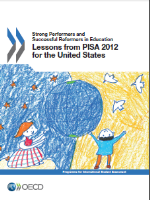United States
Strong Performers and Successful Reformers in Education - Lessons from PISA 2012 for the United States
|
This report situates the performance in PISA of 15-year-olds in the United States against global patterns and trends. It goes beyond the aggregate-level analysis to analyze the strengths and weaknesses of U.S. students on different types of mathematics tasks. It also reviews the relationship with the Common Core State Standards for Mathematics (CCSSM) in order to help connect results from PISA to what the United States aspires to teach in classrooms and to inform teaching practices that can help to improve performance.
|
|
Contents
|
||
Chapter 1 |
PISA as a Yardstick for Educational Success |
|
| More and more countries are looking beyond their own borders for evidence of the most successful and efficient policies and practices. Over the past decade, the OECD Programme for International Student Assessment (PISA) has become the world’s premier yardstick for evaluating the quality, equity and efficiency of school systems. This chapter introduces PISA and sets the scene for situating the PISA performance of 15-year-olds in the United States against global patterns and trends. | ||
Chapter 2 |
Viewing the United States School System Through the Prism of PISA 2012 |
|
|
This chapter compares the United States with education systems that have performed well or are rapidly improving on PISA and other international benchmarks. It provides a backdrop for the subsequent chapters, which examine the performance of U.S. students in finer detail, including in relation to the Common Core State Standards. |
||
Chapter 3 |
Strengths and Weaknesses of American Students in Mathematics |
|
|
This chapter looks in more detail at American students' strengths and weaknesses in the PISA 2012 mathematics assessment. It examines the success rates of students on individual items of the test, compared with the success of students in OECD countries on average and in comparison with five comparator or reference countries/economies. The analysis points to aspects of mathematics teaching that might be strengthened in order to improve the performance of the United States. |
||
Chapter 4 |
PISA and the U.S. Common Core State Standards for Mathematics |
|
| How does PISA relate to the education standards that apply within the United States? Most U.S. States have adopted the Common Core State Standards for Mathematics (CCSSM) as their state mathematics standard. A relevant question therefore is how performance measured by PISA relates to the CCSSM and whether faithful implementation of CCSSM is likely to improve the U.S. performance in the PISA test? This chapter provides an initial investigation into this. |
||
Annex A1 |
The PISA Approach to Assessing Student Performance in Mathematics |
|
> Back to PISA 2012 Results for Volumes I, II, III and IV
Related Documents

